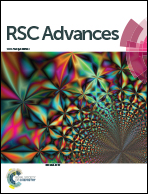Alumina membrane coated activated carbon: a novel strategy to enhance the mechanical properties of a solid catalyst†
Abstract
This paper presents a novel strategy to enhance the mechanical properties of a solid catalyst. By employing a slip-casting method, an alumina membrane can be prepared on the surface of activated carbon particles uniformly. Significantly, the mechanical properties test indicates that the attrition index of activated carbon decreases from 12.6% to 2.9% due to the alumina membrane coating.


 Please wait while we load your content...
Please wait while we load your content...